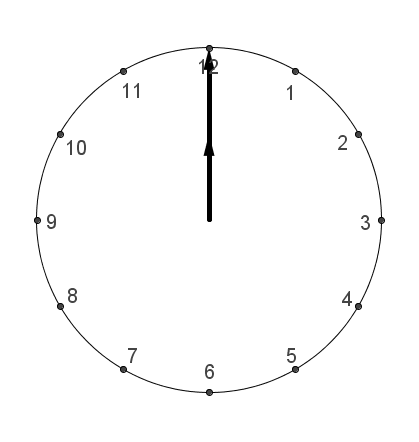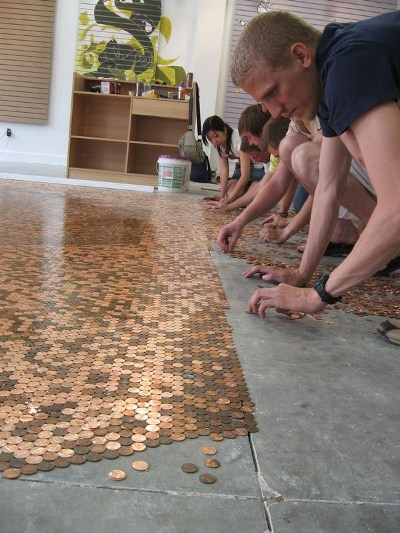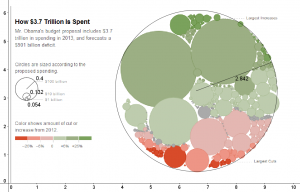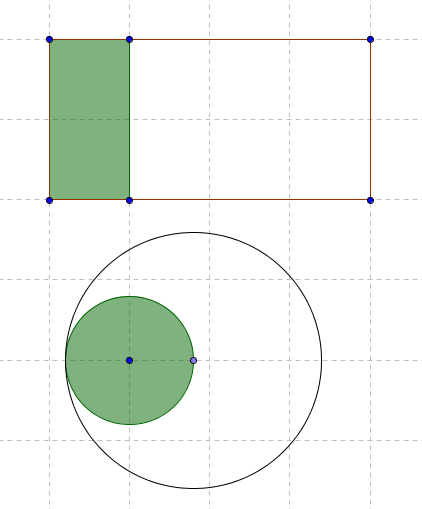Coin Problems — what are they structuring?
@ddmeyer appeal to coins already an attempt at “real”/accsble . But strange constraints to know. Scrap&Stepback: 2eq2var: Whats intrstng?hmm
— Scott Farrar (@farrarscott) October 15, 2014
Dan Meyer posted a classic example of a “coin problem” the other day on Twitter. The problem was in Pearson’s Common Core Algebra 2 text. Lets assume positive intent from Pearson’s authors in their choice of inclusion here, since at first glance, it may not seem very “common corey”. But actually, regardless of their intent, lets see where this kind of problem has (1) traditionally taken us and (2) what we can do with it to explore non-traditional approaches.
This post is adapted from my comments in Dan’s thread.
Mark has 42 coins consisting of dimes and quarters. The total value of his coins is $6. How many of each type of coin does he have? Show all your work and explain what method you used to solve the problem.
What kind of problem is this? Usually this comes up during a systems of linear equations unit in an Algebra 1 class. The text itself is an Algebra 2 book, so we’re probably safe to assume their intent is to use it as an example of a slightly dressed up system of lines exercise.
So my thoughts are to step back a little bit. (1) its 2 equations and 2 unknowns — what is interesting and important about those? What kind of mathematical structure is this? (2) What does the context of coins do to our structure? (3) Does the coin context add to our ability to uncover the underlying structure?
Intro
Consider its a little strange to know how many coins you have but not how many of each denomination. An initial sign of contrived context that students pick up on. Mostly by high school, students have formed some identities in the classroom that oblige them to cooperate with teacher instruction, so if they’re not initially interested, they may hang with you a little bit. But perhaps some loudmouth in your class will point out some of the strangeness of the contrived situation. #embracetheloudmouth
So perhaps at some point during the lesson series you then have the opportunity to say, “you’re totally right, Lou D’mouth, in what situation could we know the number of coins total and their value total, but not their partition?”
This is where you can set up the class to turn this coin problem on its head, as it were. (rimshot!)
Letting the kids “get meta”
I like Denise Gaskins’s @letsplaymath idea: Turn it into a 20-questions game: Stu reach into coin jar & grab handful, others ask Qs to find out what coins they have.?
This changes the requirements of the task: not only do we want to find a solution but we care ostensibly about how efficiently we can do it with respect to the number of questions asked. Why does it take at least two questions? Denise’s activity might not go on very long but that’s fine because why will the students stop doing it? They’ll figure out how easy it is! They’ll wrap their heads around it. Maybe the teacher can explicitly challenge groups to try to ask a single question to answer # of quarters and # of dimes.
(Presumably, we’re going to disallow “how many quarters?” although its still interesting that we still need two questions there…)
Furthering this section could be questions like:
Q. If you ask “how many quarters?” and they respond “8” then why does that not let us know how many coins are in their hand?
Expand on the Structure
Now we can acknowledge the contrivance because its going to lead us to something special about this mathematical structure. We acknowledge and loosen our contrivance: parameterize the # of coins. A number of people on twitter responding to Dan had this idea in addition to myself.
(Lets make the numbers smaller) Say we have $2.00 If we only use quarters and pennies… how many coins do we need? N=8 coins (8q0p) is one way… N=104 is another (ask how!).
1. spend some time finding Ns. mathematical practice standard: make use of structure! (How do we know when we’re done?)
2. To add up to $2.00 does every N (coin total) break down into only one quarter and penny partition? why?
3. Why do some Ns (105 e.g.) not have any solutions?
4. ***What is it about the quarters and pennies, Ns, and $ totals that forces us to have unique solutions or not?***
and 5. Can we contrive a coin-situation so that there are $s,Ns with multiple quarter-penny partitions? Is this possible?
Think back to when you were a student
I remember a lot of handwaving and “worship” in my own education towards the fact that 2 equations and 2 unknowns has a solution. (and 3 eq, 3 unknowns, etc…)
But statements like “ok so this is 2 equations and 2 unknowns so we know how to do it” are exactly what contribute to the magic spellbook idea of math. Kids feel that those who are good at math know the right spells to incant, and “2 equations 2 unknowns” must be a pretty good spell if it makes answers appear out of nowhere!
Don’t solve too quickly
I think this would be a rare case in which I would NOT go for a graph quickly. Yeah, we know about intersections of lines. Yeah we can show these coin relationships are linear.
But can we justify to ourselves that this idea of limited solutions based upon # of constraints is generalizable? We start with quarters pennies sure. In the middle maybe we prove something about # of solutions of systems and we talk about other ideas like mixtures and such. But by the end? We need students to grok (http://en.wikipedia.org/wiki/Grok) this idea of systems and solutions.
Descartes before dehorse
Maybe this is something that the teacher holds in his or her head. But the deeper and richer the teacher is thinking about the mathematical structure, the more links and hooks and connections can be made between student ideas. Here we might think about the genius of the Cartesian plane a little bit:
The graph informs us of:
– the infinite nature of the linear models
– the monotonic nature of the linear models
– the difference in ratios between coinA:coinB and valueA:valueB (thus different slopes)
– all of the ordered pairs that fit the conditions of the coin count
– all of the ordered pairs that fit the conditions of the value total
And combining our geometric knowledge about lines at different angles, mapping that onto the linear models, mapping THAT onto the coin situations… that’s how we are justifying our singular solution.
How this all might play out in a classroom would be just that extra 15 seconds of wait time, that extra question for group discussion, that incremental food for thought…
Not so much that we want a full answer, but that we want the students to take up the role of justification.
T, to S: “Why DO we know there is one solution here…?”
Let the students bring it out into the discussion
And if S reasons via graph, great!
But S might say something like: “well if we take off a quarter, and add a time, we keep the coin total at 42, but lose value…. we’ll always lose value at this way so there can be no solutions with more quarters!”
That’s (a) proof by contradiction and (b) using concepts that apply for theory of functions: decreasing, monotonic. (in this case its a sequence) But also the S has synthesized a hypothetical that generalizes to a larger case: take off a quarter, add a dime. Then they’ve upped their abstraction by arguing that any case like that will not provide a solution. (And similar arguments can work for adding a quarter, subtracing a dime)
Then T has the opportunity to engage the class in a discussion of bridging the graphical and the deductive reasonings.
It may very well end up becoming a discussion on why Cartesian graphs are so great, and all the better! Lots of students struggle with graphing because they are stuck on procedure without realizing what a graph represents specifically in an instance, or generally.
Bouncing off the Literature
In the beginning of this post I brought up the idea that a student will go along with some ridiculous contrived situations because they feel obligated to conform to a certain identity in a math class. I’m considering this in the context of Dr. Paul Cobb’s 2009 article regarding how students create, maintain and alter their identities during their education. This can be a bad thing, as in the case study course:
The frustration and disenchantment that all the students voiced indicated that they were not identifying with mathematical activity as it was realized in this classroom but were instead merely cooperating with the teacher. (Cobb, 2009)
P., Gresalfi, M., & Hodge, L. L. (2009). An interpretive scheme for analyzing the identities that students develop in mathematics classrooms.Journal for Research in Mathematics Education, 40-68.
When thinking about classroom discussions, I enjoyed Walshaw and Anthony’s 2008 paper on classroom discussions. A favorite quote:
Unless teachers make good sense of the mathematical ideas they hear in class, they will not develop the flexibility they need for spotting the golden opportunities and wise points of entry that they can use for moving students toward more sophisticated and mathematically grounded understandings. Reflecting on the spot and dealing with contested mathematical thinking demand sound teacher knowledge. Importantly, the way in which teachers manage multiple viewpoints is very much dependent on what they know and believe about mathematics and on what they understand about the teaching and learning of mathematics.
Walshaw, M., & Anthony, G. (2008). The Teacher’s Role in Classroom Discourse: A Review of Recent Research Into Mathematics Classrooms. Review of Educational Research, 78(3), 516–551.





